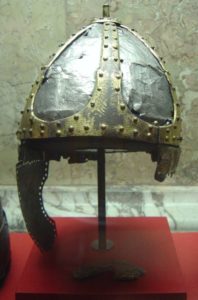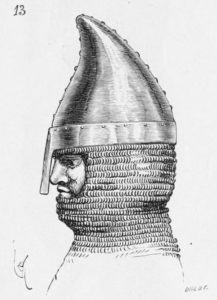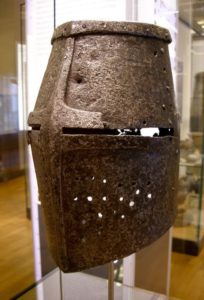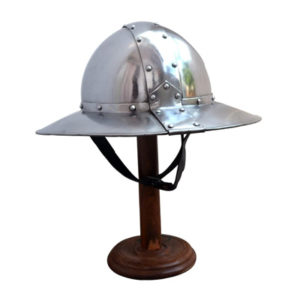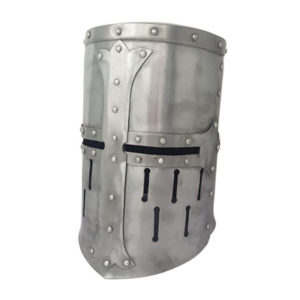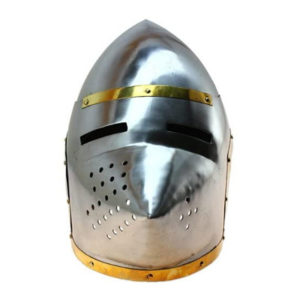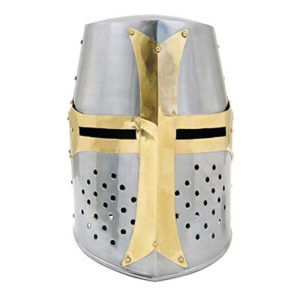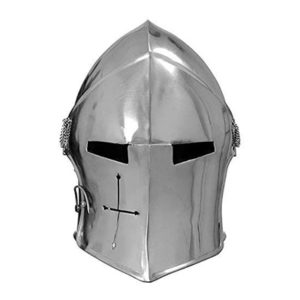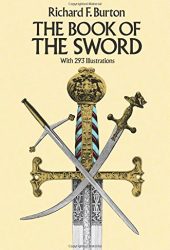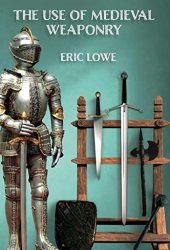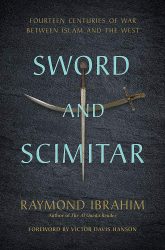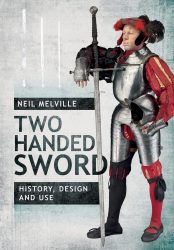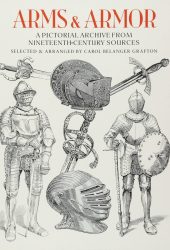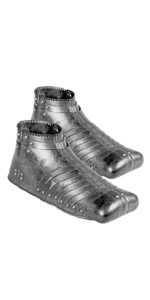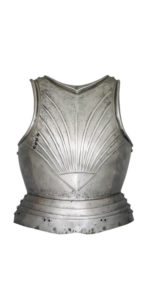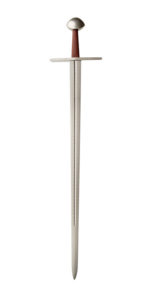The medieval Helmet was a form of protective gear worn to protect the head, or sometimes for ceremonial or symbolic use. We can find early examples of helmets in the Mycenean and Greek cultures, with designs from one region being used as bases for new developments in another.
During the Middle Ages, many different helmets, almost all made of metal, were developed. Among them are the spangenhelm, the great helm, the bascinet, and the frog-mouth helm, mostly for jousting tournaments.

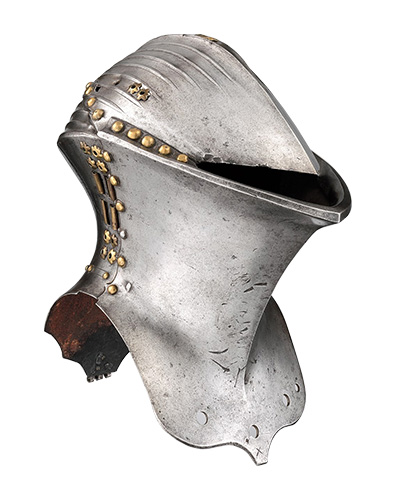
History of the Helmet
One of the earliest examples of helmets found in the archaeological registry is the boar’s tusk helmet, an incredible Mycenaean piece from the 17th century BC. Made with slivers of boar tusks attached to a leather base and padded with felt; this helmet is actually mentioned in the description of a boar’s tusk helmet that appears in book ten of Homer’s Iliad, as Odysseus is armed for a night raid to be conducted against the Trojans. Conic helmets have been apparently represented in several Aegean cultures, such as in the Phaistos disc and Akrotiri.
Assyrian soldiers in 900 BC also wore thick leather or bronze helmets to protect the head from blunt objects, sword blows, and arrows. The Greeks created a design that has been featured in countless movies, the Greek Hoplite helmet or Corinthian helmet, which covered most of a warrior’s face and had huge cheek plates and a long nasal that left very of the face exposed.
Earlier Roman helmets were based on Celtic designs. However, in the late 3rd century, a complete break in Roman helmet design occurred, inspired by advances developed in the Sassanid Empire. The difference was that in the new helmets, the skull is constructed from more than one element. This type of ridge helmet gave origin in medieval times to the spangenhelm from the 6th to 10th centuries, slightly conical and with chain mail aventails that protect the neck’s back. The Sutton Hoo helmet, although it has more in common with a Roman Cavalry helmet, is a derivation of the spangenhelm.
Types of Medieval Helmets

Spangenhelm
These helmets were created between the fall of the Roman Empire and the Norman conquest’s start and were a popular medieval European combat helmet. Spangen refers to the metal strips that form the helmet’s framework and could be translated as braces, and -helm means helmet. The conical frame held strips connecting three to six steel or bronze plates. These helmets sometimes have face masks chain mail for the back of the neck. The spangenhelm was effective protection that was relatively easy to produce.
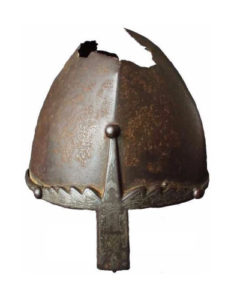
Norman or Nasal Helmet
Nasal helmets, usually conical, had a projecting bar covering the nose and protecting the face’s center. The helm style slowly replaced the spangenhelms during the 9th century, and we can see them being worn by the Normans who fought at the Battle of Hastings under William the Conqueror. The helmet could be raised from a single sheet of iron or be of composite, segmented construction.
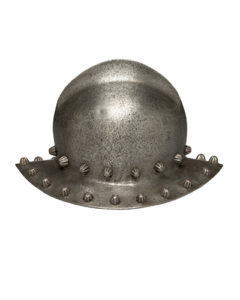
Kettle Helm
This 11th-century helmet, known as Kettle Hat or War Hat (created earlier but most popularised around that time) had wide metal brims and was made of iron or steel. Most kettle helms didn’t provide any face protection – only the brim did. The name comes from its resemblance to a cooking pot, the original meaning of kettle. Common in all of Europe, this helmet was referred to as Eisenhut in German and Chapel de fer in French (both meaning “Iron hat”).
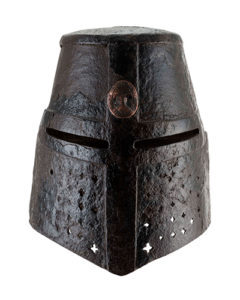
Great Helm
The great helm covered the entire head and arose in the late twelfth century in the context of the Crusades. It remained in use until the fourteenth century. The great helm is believed to have evolved from the nasal helmet. Although the great helm offered vastly superior protection than previous helmets, it also limited the wearer’s peripheral vision, provided little ventilation was was very heavy. The evolved form of the great helm was curved to deflect blows.
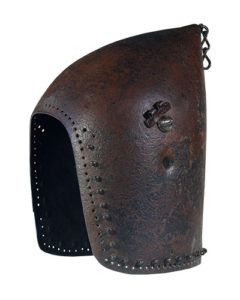
Bascinet
The bascinet was an open-faced helmet with a more pointed apex to the skull, perhaps influenced by Byzantine or Middle-Eastern Muslim helmets. It extended downwards at the rear and sides to afford protection for the neck, and a mail curtain (or aventail) was usually attached to the lower edge of the helmet to protect the throat, neck, and shoulders. Early in the fifteenth century, the camail began to be replaced by a plate metal gorget, giving rise to the so-called “great bascinet.” Attaching a muzzle or a beak visor to the bascinet made the helmet a hounskull. It’s believed that the bascinet evolved from a simple iron skullcap known as the cervelliere.
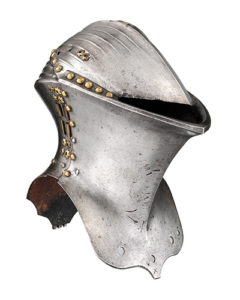
Frog-mouth helm
This was a type of great helm that appeared around 1400 and lasted into the first quarter of the 16th century. Mounted knights primarily used it for jousting tournaments rather than on the battlefield. During jousting, the helmet offered a better degree of protection from lances that would splinter after impact with the rival’s body armor. It receives this name because of its ocularium (the slit through which the wearer of the helm could see) resembling the open mouth of a frog.
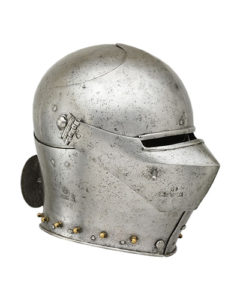
Armet
The armet was developed in the 15th century and completely enclosed the head while being compact and light enough to move with the wearer. The typical armet consisted of four pieces: the skull, the two large hinged cheek-pieces which locked at the front over the chin, and a visor which had a double pivot, one either side of the skull.

